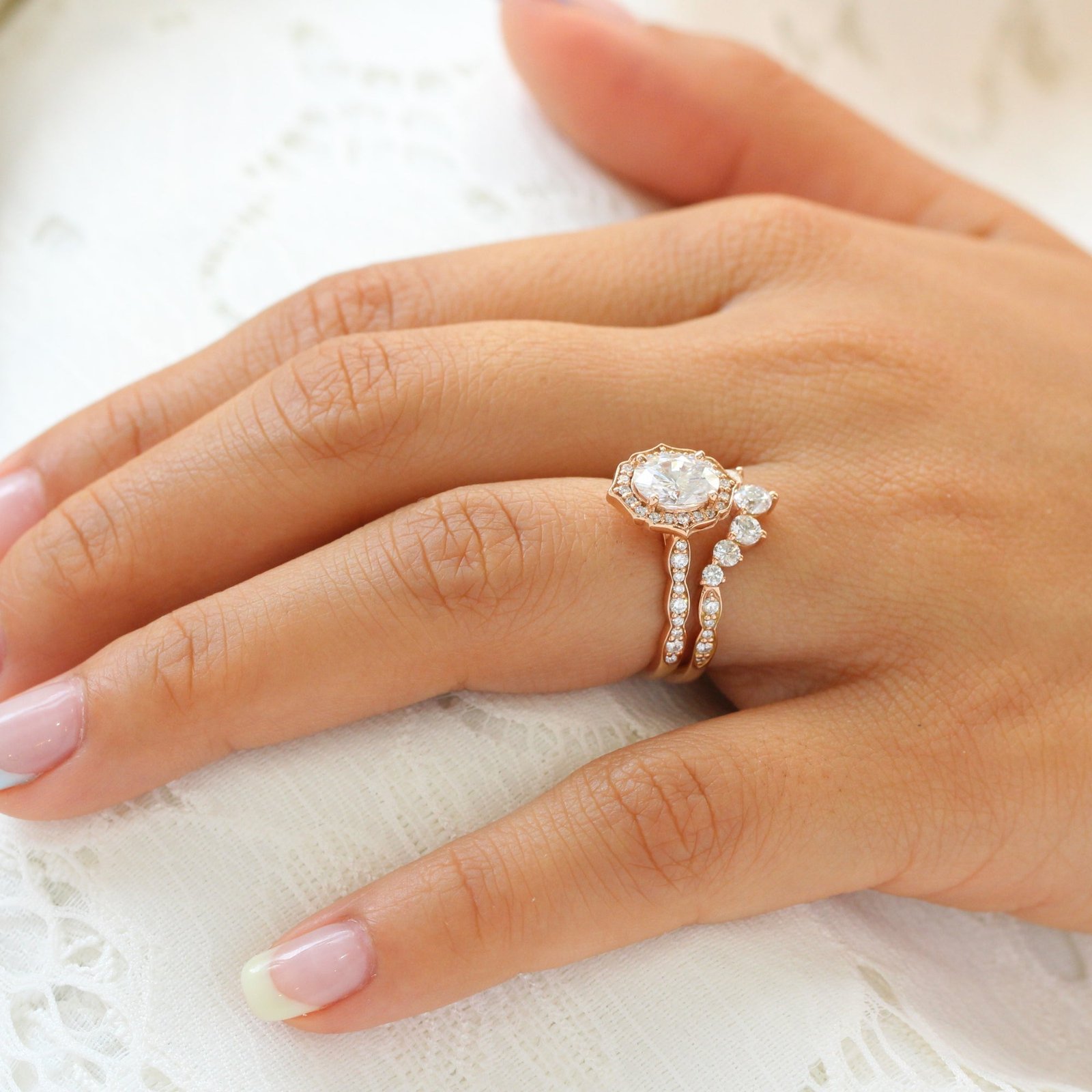When you receive a sparkling engagement or wedding ring, you expect it to be the real deal—a symbol of everlasting love and a piece that holds immense value. But how can you be sure it’s authentic?
Table of Contents
ToggleIn today’s market, imitation diamonds and counterfeit metals have become increasingly common. Whether you inherited a ring, purchased it online, or received it as a gift, it’s essential to know how to tell if your engagement or wedding ring is real. At Rogers & Brooke Jewelers, we believe in empowering customers with knowledge and offering expert evaluations to ensure the authenticity of their most treasured pieces.
Let’s dive into the signs, tests, and professional tips to determine whether your ring is the real deal.
1. Start with the Diamond Test
The most common feature people question is the diamond in an engagement or wedding ring. Here’s how you can do a quick at-home check:
The Fog Test
Breathe on the stone. A real diamond disperses heat quickly, so the fog should disappear within one second. If it stays foggy for longer, it might be a fake.
Water Drop Test
Drop the loose stone into a glass of water. Real diamonds are dense and will sink. Most imitations, like cubic zirconia, will float or sink slowly.
Check for Sparkle
Real diamonds reflect light in a specific way. They give off white light (brilliance) and rainbow-colored light (fire). If your ring seems too colorful or “glassy,” it might not be a real diamond.
2. Examine the Ring’s Setting and Mount
Even if the stone looks real, the metal setting can tell you a lot. Authentic engagement or wedding rings are typically set in high-quality metals like:
-
Platinum
-
18K or 14K gold (white, yellow, or rose)
-
Palladium
Look inside the band for hallmarks like “PT950”, “18K”, or “750”. If you see “CZ,” it stands for cubic zirconia, a synthetic alternative.
At Rogers & Brooke Jewelers, all our bridal rings come with certified settings and hallmark stamps to ensure authenticity.
3. Use a Loupe or Magnifying Glass
Jewelers often use a 10x loupe to inspect rings. You can use a basic magnifying glass to check for:
-
Natural flaws or inclusions: Real diamonds usually have tiny internal imperfections.
-
Laser inscriptions: Certified diamonds often have a microscopic GIA number etched on the girdle.
-
Craftsmanship: Real rings exhibit precise detailing, sharp edges, and high-quality prongs.
4. Try the Scratch Test (With Caution)
Diamonds are the hardest substance on Earth. If you gently try to scratch glass or a mirror with your diamond and it leaves a mark, it’s likely real. However, this method isn’t foolproof and might damage either surface. We advise using this as a last resort or consulting an expert.
5. Check for Weight and Temperature
Fake stones like moissanite or glass usually feel lighter than real diamonds. Also, real diamonds are good conductors of heat and feel cold to the touch.
If your engagement or wedding ring feels unusually warm or light, it may not be authentic.
6. Seek Professional Appraisal
No home test can beat the accuracy of a certified gemologist. At Rogers & Brooke Jewelers, we offer free ring inspections and professional appraisals, ensuring you receive a verified report of your ring’s authenticity, value, and diamond grade.
Here’s what professionals evaluate:
-
Carat weight
-
Cut, clarity, and color
-
Diamond certification (GIA, IGI, AGS)
-
Metal authenticity
-
Market valuation
7. Ask for Certification
One of the best ways to guarantee the authenticity of your engagement or wedding ring is through diamond certification. Reputable jewelers like Rogers & Brooke Jewelers always provide certificates from trusted institutions like:
-
GIA (Gemological Institute of America)
-
IGI (International Gemological Institute)
-
AGS (American Gem Society)
These certificates confirm that your diamond has been evaluated under strict standards and isn’t a synthetic or imitation gem.
8. Be Cautious of Suspicious Deals
If a deal seems too good to be true, it usually is. Watch out for:
-
Online sellers without reviews or certifications
-
Extremely low prices on large-carat diamonds
-
No return policy or warranty
With Rogers & Brooke Jewelers, you always receive transparent pricing, lifetime guarantees, and expert guidance to ensure every engagement or wedding ring you buy is genuine.
9. Watch for Common Fakes
Here are a few materials that are commonly used to replicate diamonds:
-
Cubic Zirconia (CZ): Cheap and visually similar but lacks durability and sparkle.
-
Moissanite: Very close in appearance to diamonds but exhibits a rainbow sparkle under light.
-
White Sapphire: Less brilliant and can scratch more easily.
If you suspect your engagement or wedding ring contains one of these stones, a simple lab test at Rogers & Brooke Jewelers can give you the answer.
10. Don’t Forget the Metal
It’s not just about the stone. Your ring’s band plays an essential role in value. Here’s how to check the authenticity of the metal:
-
Use a magnet: Real gold and platinum are not magnetic. If your ring sticks to a magnet, it’s likely fake.
-
Acid test: Professionals use a safe chemical process to verify metal purity.
-
Look for tarnishing: Pure gold and platinum do not tarnish easily, while fake metals often discolor over time.
Why Trust Rogers & Brooke Jewelers?
With decades of experience in fine jewelry, Rogers & Brooke Jewelers is a name that couples trust. Whether you’re shopping for your dream bridal set or verifying the authenticity of your current piece, we offer:
-
Complimentary evaluations
-
Certified diamonds with official documentation
-
Expert gemologists on-site
-
A transparent and supportive buying process
Every engagement or wedding ring we sell is backed by a promise of quality, ethics, and authenticity.
Final Thoughts
Knowing how to tell if your engagement or wedding ring is real protects not only your investment but also the emotional significance it holds. From basic at-home tests to full professional assessments, there are plenty of ways to verify your ring’s authenticity.
